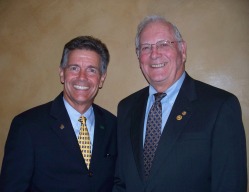JULY 31, 2012 ROTARY IN REVIEW:
Jim Ketcham presents "The Fool Soldiers" of the Dakota Conflict
Club 10 Business Report
President Dan McKeown brought the meeting to order at 12:30 p.m. on a warm summer Tuesday in downtown Saint Paul. Jerry Faletti led the assembled Rotarians in singing God Bless America, accompanied by Bob Jones on the piano. Carol Bufton provided today's invocation. Todd Kruse facilitated the introduction of visiting Rotarians and guests. Today's Greeters were Chuck Field and Kathleen Riley.
Carolyn Brusseau reminded everyone that the Roast for past president Doug Bruce is this coming Thursday, August 2nd, at The Lexington with libations beginning at 6:00 followed by the Roast at 6:30. Derek Sharrer invited everyone to the "Game with the Saint Paul Saints" on Sunday, August 26th, with registration available through SAINTSGROUPS.com (password: rotary). Mick White asked all members to participate in the Club 10 Blood Drive on Tuesday, August 14th. Vicki Gee- Treft reported on the upcoming visit by the Friendship Exchange Team from Taiwan inviting all to a special event on Friday, September 21st, 7-9 p.m. aboard the Jonathan Paddleford. Guests welcome! Registration available at the Club website. Jerry Faletti returned to the podium to make a Paul Harris Fellowship presentation to Jim Kosmo. This was a one stone ruby pin for Jim representative of the more than $7,000 in donations that he and his wife have made to the foundation. Sarah Kolar collected Happy Dollars today.
Treft reported on the upcoming visit by the Friendship Exchange Team from Taiwan inviting all to a special event on Friday, September 21st, 7-9 p.m. aboard the Jonathan Paddleford. Guests welcome! Registration available at the Club website. Jerry Faletti returned to the podium to make a Paul Harris Fellowship presentation to Jim Kosmo. This was a one stone ruby pin for Jim representative of the more than $7,000 in donations that he and his wife have made to the foundation. Sarah Kolar collected Happy Dollars today.
The Hon. John Guthmann introduced today's speaker, Jim Ketcham, a founding member and Past President of the Uptown Rotary Club and amateur historian. Mr. Ketcham currently lives in Elmira, N.Y. He has degrees from Western Michigan University and the Chicago Theological Seminary. He was with Club 10 today as the first of twp parts to be continued next week on the topic of the Dakota/Lakota Conflict of 1862. This conflict occurred in the young State of Minnesota and the Dakota Territory culminating with the execution of 38 Native Americans by mass hanging in Mankato, MN, late that year.
Mr. Ketcham shared three strains of the story of the "Fool Soldiers" or "Crazy Soldiers," young Lakota warriors named "Kills Game" and "Charger" and their followers. Through interpretation of a dream experienced by the warrior Kills Game, these Lakota believed that the way to demonstrate strength and bravery was to be kind and generous. The story of the Fool Soldiers begins with the Battle of Lake Chetek, Minnesota, in late August 1862. At the end of that battle, the women and children of two white families, the Wrights and the Dooleys, were captured by the Lakota chiefs White Lodge and Lean Bear. Through each version of the story shared by Mr. Ketcham, the Fool Soldiers attempted to either rescue the white hostages outright or negotiate for their release. One version of the story even suggests that the Fool Soldiers protected the white family members through a blizzard as they attempted to return them across 100 miles of Dakota Territory to the military outpost at Fort Randall.
Mr. Ketcham related how he stumbled across the story of the Fool Soldiers while reading a historical marker alongside a South Dakota highway. In researching their story, he discovered that the Fool Soldiers were never thanked or compensated for rescuing these families. The Fool Soldiers own families would no longer accept them after their selfless acts to help these whites. After thirty years of conflict between the whites and the plains Indians in the Dakota Territory, no one was interested in the stories of good which had occurred until Doan Robinson, head of the South Dakota Historical Society, researched the story and interviewed participants.
As a final note to the episode, Mr. Ketcham noted that Mr. Dooley, spouse of the captured Laura Dooley, was allowed to cut the master rope that hanged the 38 convicted Native Americans at Mankato. This was to allow him a measure of vengeance for the loss of his family. At the time, he did not know that due to the actions of the Fool Soldiers, his family was actually recuperating at Fort Randall.
President Dan thanked Mr. Ketcham for his presentation and adjourned the meeting at 1:31 p.m.
Chuck Standfuss, Scribe

